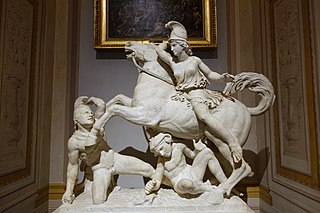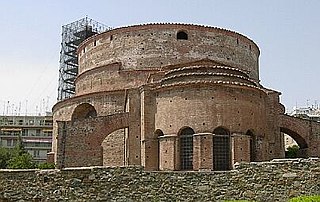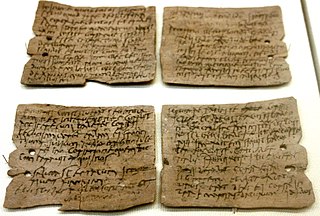


A tabula ansata or tabella ansata (Latin for "tablet with handles", plural tabulae ansatae or tabellae ansatae) is a tablet with dovetail handles. [1] It was a favorite form for votive tablets in Imperial Rome. [2]



A tabula ansata or tabella ansata (Latin for "tablet with handles", plural tabulae ansatae or tabellae ansatae) is a tablet with dovetail handles. [1] It was a favorite form for votive tablets in Imperial Rome. [2]
Tabulae ansatae identifying soldiers' units have been found on the tegimenta (leather covers) of shields, for example in Vindonissa (Windisch, Switzerland). [3] Sculptural evidence, for example on the metopes from the Tropaeum Traiani (Adamclisi, Romania), shows that they were also used for the same purpose on the shields. [4]
Tabulae ansatae have been used by modern artists from as early as the 15th century, as shown on the tomb of Charles, Count of Maine, attributed to Francesco Laurana, in Le Mans Cathedral. [5] The Statue of Liberty by sculptor Auguste Bartholdi is holding one such tablet on which "July IV MDCCLXXVI" is inscribed.

The Arc de Triomphe de l'Étoile is one of the most famous monuments in Paris, France, standing at the western end of the Champs-Élysées at the centre of Place Charles de Gaulle, formerly named Place de l'Étoile—the étoile or "star" of the juncture formed by its twelve radiating avenues. The location of the arc and the plaza is shared between three arrondissements, 16th, 17th (north), and 8th (east). The Arc de Triomphe honours those who fought and died for France in the French Revolutionary and Napoleonic Wars, with the names of all French victories and generals inscribed on its inner and outer surfaces. Beneath its vault lies the Tomb of the Unknown Soldier from World War I.

The Statue of Liberty is a colossal neoclassical sculpture on Liberty Island in New York Harbor in New York City, in the United States. The copper statue, a gift from the people of France, was designed by French sculptor Frédéric Auguste Bartholdi and its metal framework was built by Gustave Eiffel. The statue was dedicated on October 28, 1886.

In Greek mythology, Amazonomachy was one of various mythical battles between the ancient Greeks and the Amazons, a nation of all-female warriors. Many of the myths portrayed were that of Heracles' ninth labor, which was the retrieval of the girdle of Hippolyta, Queen of the Amazons; and of Theseus' abduction of Hippolyta, whom he claimed as his wife, sparking the Attic War. Another famous scene portrayed is that of Achilles' victorious battle against Penthesilea during the Trojan war.
The pilum was a javelin commonly used by the Roman army in ancient times. It was generally about 2 metres long overall, consisting of an iron shank about 7 mm in diameter and 60 cm (24 in) long with a pyramidal head, attached to a wooden shaft by either a socket or a flat tang.

The Arch of Galerius or Kamara (Καμάρα) and the Rotunda (Ροτόντα) are neighbouring early 4th-century AD monuments in the city of Thessaloniki, in the region of Central Macedonia in northern Greece. As an outstanding example of early Byzantine art and architecture, in addition to the importance of the Rotunda as one of the earliest Christian monuments in the Eastern Roman Empire, both sites were inscribed on the UNESCO World Heritage List in 1988 as part of the Paleochristian and Byzantine monuments of Thessaloniki.

The falx was a weapon with a curved blade that was sharp on the inside edge used by the Thracians and Dacians. The name was later applied to a siege hook used by the Romans.

Italica was a Roman town founded by Italic settlers in Hispania; its site is close to the town of Santiponce, part of the province of Seville in modern-day Spain. It was founded in 206 BC by Roman general Scipio as a settlement for his Italic veterans and named after them. As time progressed, Italica grew attracting new settlers from the Italian peninsula and also with the children of Roman soldiers and native women of Iberia. A branch of the Gens Ulpia from the Umbrian city of Tuder and a branch of the gens Aelia from the Picenian city of Atri were either among the original settlers of Italica or among the groups that later moved in the town, as these were the respective stirpes of the Roman emperors Trajan and Hadrian, who were born in Italica. According to some authors, Italica was also the birthplace of Theodosius.

The Tropaeum Traiani or Trajanic Trophy is a monument in Roman Civitas Tropaensium, built in AD 109 in then Moesia Inferior, to commemorate Roman Emperor Trajan's victory over the Dacians, in the winter of 101–102, in the Battle of Adamclisi. Before Trajan's construction, an altar existed there, on the walls of which were inscribed the names of the 3,000 legionaries and auxilia (servicemen) who had died "fighting for the Republic"..

Triglyph is an architectural term for the vertically channeled tablets of the Doric frieze in classical architecture, so called because of the angular channels in them. The rectangular recessed spaces between the triglyphs on a Doric frieze are called metopes. The raised spaces between the channels themselves are called femur in Latin or meros in Greek. In the strict tradition of classical architecture, a set of guttae, the six triangular "pegs" below, always go with a triglyph above, and the pair of features are only found in entablatures of buildings using the Doric order. The absence of the pair effectively converts a building from being in the Doric order to being in the Tuscan order.

The Battle of Adamclisi was a major battle in the Dacian Wars, fought in the winter of 101 to 102 between the Roman Empire and the Dacians near Adamclisi, in modern Romania.

The Vindolanda tablets were, at the time of their discovery, the oldest surviving handwritten documents in Britain. They are a rich source of information about life on the northern frontier of Roman Britain. Written on fragments of thin, post-card sized wooden leaf-tablets with carbon-based ink, the tablets date to the 1st and 2nd centuries AD. Although similar records on papyrus were known from elsewhere in the Roman Empire, wooden tablets with ink text had not been recovered until 1973, when archaeologist Robin Birley, his attention being drawn by student excavator Keith Liddell, discovered some at the site of Vindolanda, a Roman fort in northern England.

Veleia is an ancient town of Aemilia, Italy, about 15 km (9 mi) south of Placentia. It is mentioned by Pliny among the towns of the eighth region, though the Veleiates were ethnically Ligurians. Its inhabitants were, in the census of Vespasian, found to be remarkable for their longevity. Nothing further was known of it until 1747, when some ploughmen found the Tabula alimentaria, now in National Archaeological Museum of Parma. This, the largest inscribed bronze tablet of antiquity contains the list of estates in the territories of Veleia, Libarna, Placentia, Parma and Luca, in which Trajan had assigned before 102 CE 72,000 sesterces and then 1,044,000 sesterces on a mortgage bond to forty-six estates. The total value of which was reckoned at over 13,000,000 sesterces (~130,000), the interest on which at 5% was to serve for the support of 266 boys and 6 girls, the former receiving 16, the latter 12 sesterces a month.

The Tabulae Iliacae are a collection of 22 stone plaques (pinakes), mostly of marble, with reliefs depicting scenes from Greek epic poetry, especially of the Iliad and the Trojan War. They are all of early Imperial Roman date, and seem to have come from two Roman workshops, one of which seems to have been designed to satisfy a clientele of more modest aspirations.

The National Museum of Damascus is a museum in the heart of Damascus, Syria. As the country's national museum as well as its largest, this museum covers the entire range of Syrian history over a span of over 11 millennia. It displays various important artifacts, relics and major finds most notably from Mari, Ebla and Ugarit, three of Syria's most important ancient archaeological sites. Established in 1919, during King Faisal's Arab Kingdom of Syria, the museum is the oldest cultural heritage institution in Syria.

Prusias ad Hypium was a city in ancient Bithynia, and afterwards in the late Roman province of Honorias. In the 4th century it became a bishopric that was a suffragan of Claudiopolis in Honoriade. Before its conquest by King Prusias I of Bithynia, it was named Cierus or Kieros. Photius writes that it was called Kieros, after the river which flows by it.
The column of Arcadius was a Roman triumphal column in the forum of Arcadius in Constantinople built in the early 5th century AD. The marble column was historiated with a spiralling frieze of reliefs on its shaft and supported a colossal statue of the emperor, probably made of bronze, which fell down in 740. Its summit was accessible by an internal spiral staircase. Only its massive masonry base survives.

The Antonino Salinas Regional Archeological Museum is a museum in Palermo, Italy. It possesses one of the richest collections of Punic and Ancient Greek art in Italy, as well as many items related to the history of Sicily. Formerly the property of the Oratory of Saint Philip Neri, the museum is named after Antonino Salinas, a famous archaeologist and numismatist from Palermo who had served as its director from 1873 until his death in 1914, upon which he left it his major private collection. It is part of the Olivella monumental complex, which includes the Church of Sant'Ignazio all'Olivella and the adjoining Oratory.

Ancient Greek art stands out among that of other ancient cultures for its development of naturalistic but idealized depictions of the human body, in which largely nude male figures were generally the focus of innovation. The rate of stylistic development between about 750 and 300 BC was remarkable by ancient standards, and in surviving works is best seen in sculpture. There were important innovations in painting, which have to be essentially reconstructed due to the lack of original survivals of quality, other than the distinct field of painted pottery.
Trajanic art is the artistic production of the Roman Empire during the reign of Emperor Trajan from 98 to 117. In this period, Roman art further developed the innovations of the Flavian era, coming to definitively detach itself from Hellenistic influence.
Tabula Banasitana is an inscribed bronze tablet produced in the second century AD. Found in 1957 near the village of Banasa in Morocco, it documents how a notable of the Berber tribe of Zegrenses successfully petitioned to receive Roman citizenship for him and his family. Fergus Millar has noted its importance as "perhaps our finest documentary item of evidence for the archival procedures of the Roman emperors and for the limits and consequences of granting citizenship, as well as affording some glimpses of social structure in a marginal area of the empire." The text was published for the first time in 1971. The tablet is currently at the Museum of History and Civilizations in Rabat.